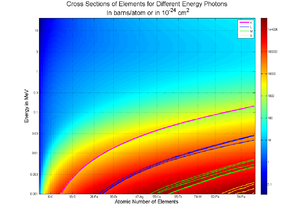| This article needs additional citations for verification. Please help improve this article by adding citations to reliable sources. Unsourced material may be challenged and removed. Find sources: "Absorption cross section" – news · newspapers · books · scholar · JSTOR (October 2018) (Learn how and when to remove this message) |

In physics, absorption cross-section is a measure of the probability of an absorption process. More generally, the term cross-section is used in physics to quantify the probability of a certain particle-particle interaction, e.g., scattering, electromagnetic absorption, etc. (Note that light in this context is described as consisting of particles, i.e., photons.) A typical absorption cross-section has units of cm⋅molecule. In honor of the fundamental contribution of Maria Goeppert Mayer to this area, the unit for the two-photon absorption cross section is named the "GM". One GM is 10 cm⋅s⋅photon.
In the context of ozone shielding of ultraviolet light, absorption cross section is the ability of a molecule to absorb a photon of a particular wavelength and polarization. Analogously, in the context of nuclear engineering, it refers to the probability of a particle (usually a neutron) being absorbed by a nucleus. Although the units are given as an area, it does not refer to an actual size area, at least partially because the density or state of the target molecule will affect the probability of absorption. Quantitatively, the number of photons absorbed, between the points and along the path of a beam is the product of the number of photons penetrating to depth times the number of absorbing molecules per unit volume times the absorption cross section :
- .
The absorption cross-section is closely related to molar absorptivity and mass absorption coefficient.
For a given particle and its energy, the absorption cross-section of the target material can be calculated from mass absorption coefficient using:
where:
- is the mass absorption coefficient
- is the molar mass in g/mol
- is Avogadro constant
This is also commonly expressed as:
where:
- is the absorption coefficient
- is the atomic number density
See also
- Cross section (physics)
- Photoionisation cross section
- Nuclear cross section
- Neutron cross section
- Mean free path
- Compton scattering
- Transmittance
- Attenuation
- Beer–Lambert law
- High energy X-rays
- Attenuation coefficient
- Absorption spectroscopy
References
- "Two-Photon Absorption Measurements: Establishing Reference Standards" (PDF). Australian National University. June 8, 2007. Archived from the original on September 14, 2013. Retrieved September 14, 2013.
- Zins, E-L.; Guinet, M.; Rodriguez, D.; Payan, S. (2022-06-01). "Absolute absorption cross section of 2-EHN in IR region" (PDF). Journal of Quantitative Spectroscopy and Radiative Transfer. 283: 108141. doi:10.1016/j.jqsrt.2022.108141. ISSN 0022-4073.
 of photons absorbed, between the points
of photons absorbed, between the points  and
and  along the path of a beam is the product of the number
along the path of a beam is the product of the number  of photons penetrating to depth
of photons penetrating to depth  of absorbing molecules per unit volume times the absorption cross section
of absorbing molecules per unit volume times the absorption cross section  :
:
 .
. and
and 

 is the mass absorption coefficient
is the mass absorption coefficient is the
is the  is
is 
 is the
is the